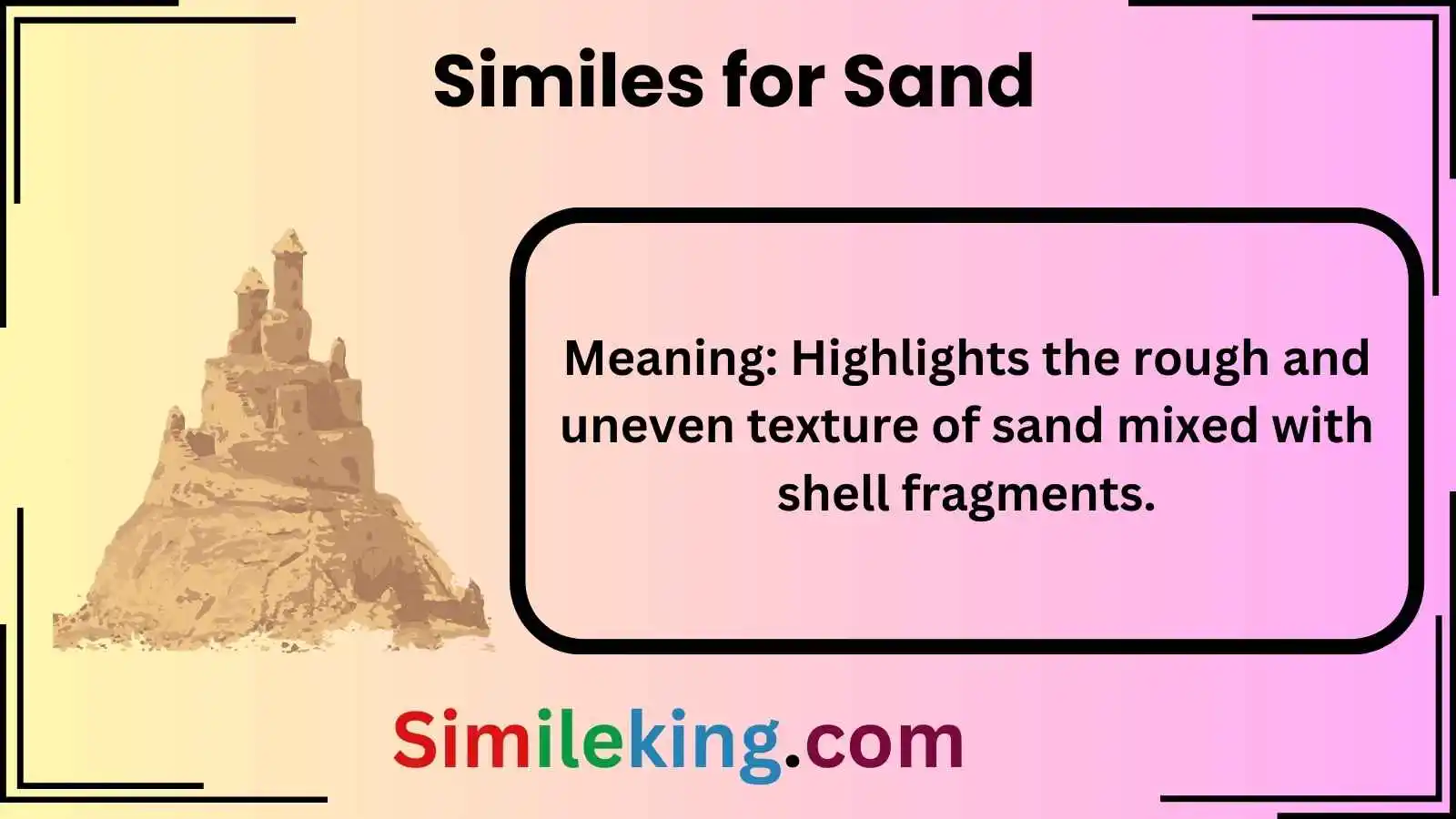Sand, with its fine grains and ever-shifting nature, has inspired countless comparisons in literature, poetry, and everyday language.
Whether describing its texture, color, movement, or abundance, similes help create vivid imagery that enhances writing and conversation.
This article explores 15+ similes for sand, breaking them down into different categories based on texture, movement, color, and more.
Alongside each simile, you’ll find explanations, examples, and usage tips.
Similes for Sand Based on Texture
1. As soft as powdered sugar
- Meaning: This simile compares fine, smooth sand to the light, powdery texture of sugar.
- Example: The beach had sand as soft as powdered sugar, making every step feel like walking on a cloud.
- Usage: Ideal for describing fine, white sand found on tropical beaches.
2. As gritty as crushed seashells
- Meaning: Highlights the rough and uneven texture of sand mixed with shell fragments.
- Example: The sand was as gritty as crushed seashells, sticking to my feet with every step.
- Usage: Suitable for describing coarser sand in rugged coastal areas.
3. As fine as sifted flour
- Meaning: This simile compares sand to finely ground flour, emphasizing its delicate consistency.
- Example: The dunes were covered in sand as fine as sifted flour, slipping easily between my fingers.
- Usage: Works well when describing ultra-soft desert sand or pristine beach sand.
4. As rough as an emery board
- Meaning: Suggests that the sand has a rough, abrasive texture, similar to a nail file.
- Example: The sand was as rough as an emery board, scratching against my bare skin.
- Usage: Best for describing coarse, grainy sand found near rocky shores.
Similes for Sand Based on Movement
5. As shifting as a restless tide
- Meaning: Highlights the ever-changing nature of sand due to wind or water.
- Example: The desert sands were as shifting as a restless tide, constantly reshaping the landscape.
- Usage: Ideal for describing desert dunes or coastal sands moved by the wind.
6. As fluid as flowing water
- Meaning: Suggests that the sand moves effortlessly, like a liquid.
- Example: The fine grains slipped through my fingers, as fluid as flowing water.
- Usage: Works well for ultra-fine sand, such as that found in hourglasses.
7. As swirling as a dust storm
- Meaning: Captures the chaotic motion of sand being carried by wind.
- Example: The sand was as swirling as a dust storm, making it impossible to see beyond a few feet.
- Usage: Perfect for describing sandstorms or strong desert winds.
8. As fleeting as footprints on the shore
- Meaning: Suggests that the sand is easily disturbed and doesn’t hold shape for long.
- Example: Her words vanished as quickly as footprints on the shore, erased by the waves.
- Usage: Useful for poetic descriptions of impermanence.
Similes for Sand Based on Color
9. As golden as morning sunlight
- Meaning: Highlights the warm, golden hue of sunlit sand.
- Example: The dunes stretched endlessly, as golden as morning sunlight.
- Usage: Ideal for describing desert landscapes or tropical beaches.
10. As white as fresh snow
- Meaning: Compares the brightness of certain beach sands to untouched snow.
- Example: The sand was as white as fresh snow, gleaming under the midday sun.
- Usage: Works well for tropical islands with fine, white sand beaches.
11. As dark as midnight shadows
- Meaning: Captures the deep, dark color of volcanic or wet sand.
- Example: The sand was as dark as midnight shadows, contrasting beautifully with the foamy waves.
- Usage: Suitable for describing black sand beaches or damp shoreline sand.
Similes for Sand Based on Abundance
12. As countless as the stars in the sky
- Meaning: Emphasizes the vast quantity of sand grains.
- Example: The desert stretched endlessly, with grains of sand as countless as the stars in the sky.
- Usage: Useful for poetic and grand descriptions of sandy landscapes.
13. As endless as time itself
- Meaning: Suggests an immeasurable or infinite quality.
- Example: The sand seemed as endless as time itself, stretching beyond the horizon.
- Usage: Great for dramatic or philosophical expressions.
14. As abundant as autumn leaves in the wind
- Meaning: Draws a comparison to the numerous falling leaves in autumn.
- Example: The sand was as abundant as autumn leaves in the wind, shifting constantly with each gust.
- Usage: Perfect for imagery-rich descriptions of moving sand.
Similes for Sand in Everyday Use
15. As clinging as wet clay
- Meaning: Highlights how damp sand sticks to surfaces.
- Example: The beach sand was as clinging as wet clay, coating my feet as I walked.
- Usage: Useful for describing the sticky nature of wet sand.
16. As dry as a parched desert
- Meaning: Emphasizes extreme dryness.
- Example: The sand was as dry as a parched desert, crumbling beneath my fingers.
- Usage: Best for depicting arid environments.
8 Texting Examples for Sand Similes
- “This beach sand is as soft as powdered sugar! ☀️🏖️”
- “The dunes are shifting like a restless tide—so mesmerizing!”
- “Walking on this sand feels like stepping on an emery board! 😂”
- “The sand here is as golden as morning sunlight—absolutely stunning!”
- “The way this fine sand flows through my fingers is like running water!”
- “The beach is covered in footprints, but they’re vanishing like waves on the shore.”
- “Wow, the sand is as white as fresh snow! Looks unreal!”
- “I can’t get this wet sand off me—it’s clinging like wet clay!”
Conclusion
Similes are powerful tools for painting vivid pictures with words, and when it comes to describing sand, the possibilities are endless. Whether you’re aiming for a poetic, dramatic, or everyday expression, the comparisons in this list can help bring your writing to life.
By choosing the right simile based on texture, movement, color, or abundance, you can craft descriptions that resonate with your audience and enhance your storytelling.





